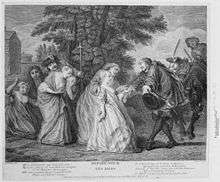Casquette girl
A casquette girl, originally known as a fille à la cassette (girl with a cassette) but also known historically as a casket girl or a pelican girl,[1] was one of the women brought from France to the French colonies of Louisiana to marry.[2][3] The name derives from the small chests, known as casquettes, in which they carried their clothes.[3][4]

They were conspicuous by reason of their virtue. Normally women were supplied to the colonists by raking the streets of Paris for undesirables, or by emptying the houses of correction. The casquette girls, however, were recruited from church charitable institutions, usually orphanages and convents, and, although poor, were practically guaranteed to be virgins.[5] For this reason it later became a matter of pride in Louisiana to show descent from them.[3]
The first consignment reached Mobile in 1704, Biloxi in 1719, and New Orleans in 1728.[3][6] They inspired Victor Herbert to write Naughty Marietta.
See also
References
- ↑ Kazek, Kelly. "When French orphans called Casket Girls came to Alabama as wives for colonists". Al.com. Retrieved 29 November 2016.
- ↑ See Dureau, Lorena. The Last Casquette Girl, 1981, Pinnacle Books ISBN 0523412665
- 1 2 3 4 Lee Smith (January 21, 2011). "Women in Colonial Louisiana". Encyclopedia of Louisiana. Louisiana Endowment foir the Humanities. Retrieved May 21, 2011.
- ↑ Higginbotham, Jay. Old Mobile: Fort Louis de la Louisiane, 1702-1711, pp.106–07. Museum of the City of Mobile, 1977. ISBN 0-914334-03-4.
- ↑ Clark, Emily. Masterless Mistresses: The New Orleans Ursulines and the Development of a New World Society, 1727–1834, pp. 12–23. Chapel Hill: The University of North Carolina Press, 2007. ISBN 978-0-8078-5822-6.
- ↑ Thomason, Michael. Mobile : the new history of Alabama's first city, pages 20-21. Tuscaloosa : University of Alabama Press, 2001. ISBN 0-8173-1065-7